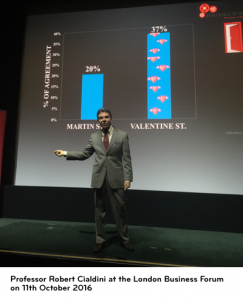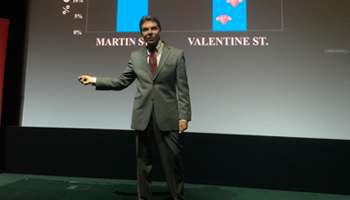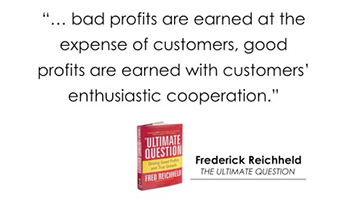Pre-suasion
 I first met Professor Robert Cialdini 14 years ago when we worked with him and his team to develop the “Principles of Persuasion” training and marketing materials, so it was great to see him at the London Business Forum last week when he presented his latest body of work which is summarised in his new book “Pre-suasion”.
I first met Professor Robert Cialdini 14 years ago when we worked with him and his team to develop the “Principles of Persuasion” training and marketing materials, so it was great to see him at the London Business Forum last week when he presented his latest body of work which is summarised in his new book “Pre-suasion”.
In summary, Cialdini’s study of many different pieces of research confirms that we can move people dramatically without their knowledge and this is achieved by putting people into the right frame of mind to be receptive to the message first. Some of the research findings are, quite frankly, unbelievable, and were it not for the rigour that I know Bob has applied to his study I might have dismissed it altogether. Even though my mind was screaming “no way”, by the end of the evening the results of the study were unarguable so please suspend your intuition for a moment and consider these facts.
An attractive young woman, struggling to read a map in Marseilles, asks a middle aged man for directions and he shows her how to get to her destination. A few minutes later he is encountered by another young woman who says “those four men over there”, pointing to a thuggish group, “have taken my mobile phone, will you get it back for me?” Perhaps not surprisingly the majority said, “sorry but no” and walked swiftly by, although 20%, 1 in 5, did confront the group (this was an experiment where the women and the youths were actors). However, by changing just one small detail in the encounter with the first woman, 37% of the men took up her cause and boldly sought to get her phone returned. So what on earth caused the number of champions to almost double? In the first set, the middle aged men were asked directions to Martin Street, in the second set they were asked how to get to Valentine’s Street. That made the difference. What? How? Why?
The reason the second set of men acted so valiantly is because of the pre-suasive effect of the word “Valentine’s” which conjures up, subconsciously, a feeling of romance. Hard to believe isn’t it although perhaps illustrates why we have the term “romantic fool”. The key is that this framing, this act of pre-suasion, happened just before the telling moment. Had it been a day earlier it wouldn’t have worked.
In case you’re thinking it’s gender biased consider this experiment. A very handsome young man approached women in a shopping centre and straight away asked them for their phone number. Now he was what my daughter might describe as “buff” but even so I find it incredible that 13.5% of the female targets complied. Even more amazing is this number increased to 24%, almost one in four, when one small change was made. In the first set the women were walking past a selection of different shops but what caused almost double to respond to the request, was when the young man asked them as they passed the florist. Flowers, with the same hidden message of romance as Valentine’s, had the same effect. And I thought only men could be that foolish.
Bob described many other research studies to illustrate his key point that when it comes to influencing people it’s what you do immediately prior to what you do that makes a massive difference. So, can you imagine what it would be like to be able to create scenarios that apply to your customers to cause them to be far more likely to choose you and your product and service rather than a competitor?
We will be sharing with our members how they can use Professor Cialdini’s latest pre-suasive techniques at our meetings in November – if you’d like to come to one you’ll find details here. Spaces are very limited, indeed at the time of writing just four are available.






